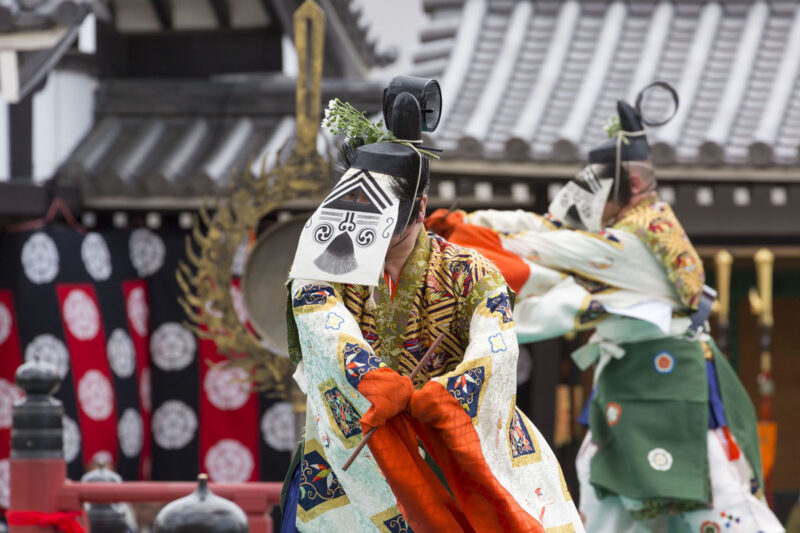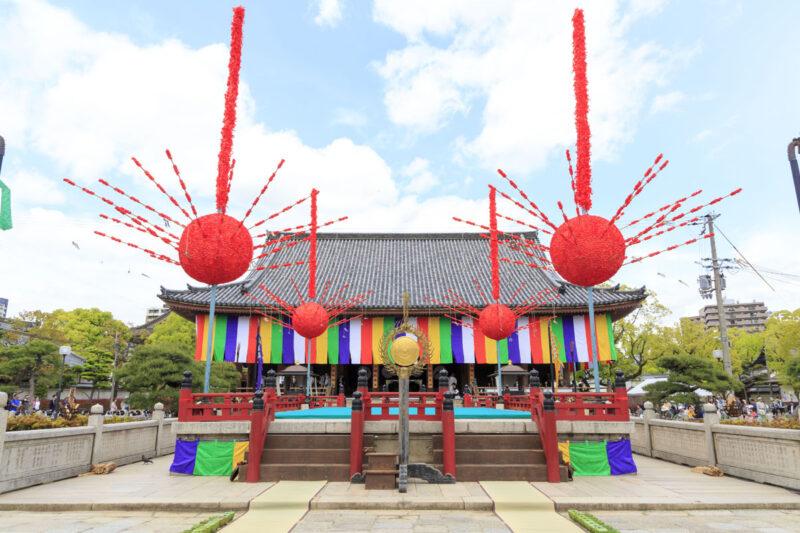Bugaku, Shōryō-e

What is Bugaku?
Bugaku is a courtly style of dance that has over 1,400 years of history in Japan and is commonly associated with religious ceremonies today. The music, masks, costumes, and movements of these dances originated on the Asian continent, and they were introduced to Japan along with Buddhism. Prince Shōtoku (574–622) contributed to the spread of bugaku and its incorporation into Buddhist ritual.
There are two main forms of bugaku: “Dances of the Right,” which mostly derive from Chinese traditions; and “Dances of the Left,” which have Korean influences. Individual dances may also show influence from Mongolia, India, and regions around Southeast Asia and the Silk Road. Although introduced alongside Buddhism, the dances were eventually incorporated into Shinto ritual, courtly ceremonies, and Kyōgen and Noh as well. The Tennōji Bugaku style, used in Shōryō-e, is one of the core styles of bugaku and is praised for its dynamism and grace.
What is Shōryō-e?
Rites called “Shōryō-e” are held on the anniversary of Prince Shōtoku’s death, April 22. They feature a series of dances accompanied by large drums and traditional instruments. Although many dances stick close to their foreign origins, some of the bugaku dances are unique to the Tennōji style, such as “Somakusha.” This dance depicts an episode from Prince Shōtoku’s life in which he was playing his flute in the mountains, and an old monkey (who was actually the spirit of the mountain) danced to the tune. A flutist plays the role of Prince Shōtoku, while a dancer in a black mask with large eyes and a bright red costume plays the role of the monkey. Other dances, like the “Kochō” butterfly dance or “Ranryō’ō” dance about a Chinese general, cover wide subject matter, and all of the Shōryō-e Bugaku Dances were collectively designated an Important Intangible Folk Cultural Property in 1976.
Bugaku is a courtly style of dance that has over 1,400 years of history in Japan and is commonly associated with religious ceremonies today. The music, masks, costumes, and movements of these dances originated on the Asian continent, and they were introduced to Japan along with Buddhism. Prince Shōtoku (574–622) contributed to the spread of bugaku and its incorporation into Buddhist ritual.
There are two main forms of bugaku: “Dances of the Right,” which mostly derive from Chinese traditions; and “Dances of the Left,” which have Korean influences. Individual dances may also show influence from Mongolia, India, and regions around Southeast Asia and the Silk Road. Although introduced alongside Buddhism, the dances were eventually incorporated into Shinto ritual, courtly ceremonies, and Kyōgen and Noh as well. The Tennōji Bugaku style, used in Shōryō-e, is one of the core styles of bugaku and is praised for its dynamism and grace.
What is Shōryō-e?
Rites called “Shōryō-e” are held on the anniversary of Prince Shōtoku’s death, April 22. They feature a series of dances accompanied by large drums and traditional instruments. Although many dances stick close to their foreign origins, some of the bugaku dances are unique to the Tennōji style, such as “Somakusha.” This dance depicts an episode from Prince Shōtoku’s life in which he was playing his flute in the mountains, and an old monkey (who was actually the spirit of the mountain) danced to the tune. A flutist plays the role of Prince Shōtoku, while a dancer in a black mask with large eyes and a bright red costume plays the role of the monkey. Other dances, like the “Kochō” butterfly dance or “Ranryō’ō” dance about a Chinese general, cover wide subject matter, and all of the Shōryō-e Bugaku Dances were collectively designated an Important Intangible Folk Cultural Property in 1976.


 List
List 